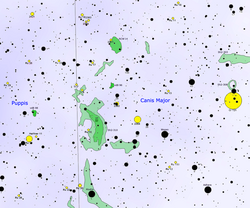VY Canis Majoris

VY Canis Majoris (VY CMa) is a red hypergiant star in the constellation Canis Major. It is about 1.2 kiloparsecs (3,900 light-years) distant from Earth. It is one of the biggest known stars in the universe, and one of the most luminous of its type.
VY Canis Majoris is 1,420 times bigger than the Sun.[1] If placed at the center of the Solar System (where the Sun is), VY Canis Majoris's surface would extend beyond Jupiter's orbit. However, there is some differences in the estimates of how big it is. Other estimates of the radius made it bigger than the orbit of Saturn or even as small as the asteroid belt,[2] but these are highly unlikely.
VY CMa is a single star, a "semiregular" variable with a period of about 2,001 days. It has an average density of 5 to 10 mg/m3.
When it dies it is expected to explode to a Supernova and then turn into a Black hole.
VY Canis Majoris Media
Portrait in bust of Jérôme Lalande in 1802
Map of the giant molecular cloud Sharpless 310 and its surroundings
Combined optical and infrared image of VY CMa and Sh2-310. The bright star at the upper right is τ Canis Majoris.(ESO/Digitized Sky Survey 2)
VLBA used to derive VY CMa's 2011 distance estimate
A visual band light curve for VY Canis Majoris, from AAVSO data
Image taken by the ESO's Very Large Telescope showing the asymmetric nebula around VY CMa using SPHERE instrument. The star itself is hidden behind a dark disk. Crosses are artifacts (lens effects) due to the characteristics of the instrument.
Right to left: VY Canis Majoris compared to Betelgeuse, Rho Cassiopeiae, the Pistol Star, and the Sun (too small to be visible in this thumbnail). The orbits of Jupiter and Neptune are also shown.
Related pages
References
- ↑ Wittkowski M. et al 2012. Fundamental properties and atmospheric structure of the red supergiant VY CMa based on VLTI/AMBER spectro-interferometry. Astronomy & Astrophysics 540: L12. [1]
- ↑ Massey, Philip; Levesque, Emily M.; Plez, Bertrand (2006). "Bringing VY Canis Majoris down to size: an improved determination of its effective temperature". The Astrophysical Journal. 646 (2): 1203–1208. arXiv:astro-ph/0604253. Bibcode:2006ApJ...646.1203M. doi:10.1086/505025. S2CID 14314968.







